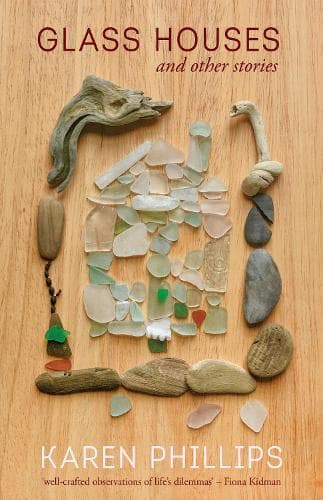Review: Glass Houses and other stories
Reviewed by Hannah Tunnicliffe
If ever there were a year for short stories, this would surely be the one. Our attention spans snipped from unexpected bursts of bad news and our anxieties made it hard to commit to a long read, so 2020 is the time to start reading collections of short stories. Karen Phillips has written an engaging introduction or addition to your existing stack with Glass Houses.
Much like the subject of the title story, each of Phillips’ stories in this collection are like a piece of well-worn, softened sea glass. There is no blood or relentless bleakness to be found, no sharpness, nothing to keep you up at night or leave you feeling wrung out. Like all good short story writers, Phillips is an expert of the micro and writes with fondness about domestic chores, miscommunication, small secrets or desires. She eschews ostentation or irritating detachment to let you into the hearts of her characters; all of them filled with love and longing, confusion and fear. Sadness and loss are amongst Phillips’ stories, sometimes at the very core of them, but all are laced with enough hope to keep you feeling optimistic, charmed or both.
All of Glass Houses’ stories are about relationships. Usually couples but sometimes parents and children. One story compares the extraction of teeth to the extraction from a partner while another features a husband packing for his wife to move to a rest home. In many of them, the characters are figuring out how to be together after one of them transforms in some way, like Julie in ‘Epiphany’ who turns to religion after the death of a son.
In all of them, Phillips weaves gentle but poignant observations and makes connections between ordinary juxtapositions. In ‘Extraction’ as the protagonist buys household basics after a separation, she listens to the checkout operator discussing an upcoming dental appointment and observes:
“It’s hard to convince myself that I’ll harden up and not notice Justin’s absence. I was the one to leave but I still look for him as often as a tongue pokes at the space left when a tooth is extracted.”
Phillips’ characters are mostly of the same ethnicity, age and class and seem as though they could all be related with only one or two degrees of separation. She often likes to place her stories in sparsely populated coastal places. It seems as though her characters could form a community somehow but perhaps that is due to the warmth with which she portrays them. I certainly wanted to know more about them by the end of each story.
Reading Glass Houses reminded me of walks at dusk around a neighbourhood: each story gifts a peek through the window into a gathering of lives, probably a more intimate and unguarded peek than observed in daylight hours. A brief, lit moment, which has you asking questions about the lives of those inside but mostly leaves you reassured. Reassured that life, love, loss and hope are going on in other homes too, in amongst washing the dishes.
Glass Houses is a small book, not much bigger than a side plate, and is full of lovely but unfussy language, relatable characters and connections made between events, characters, symbols and themes. With its cover of softened mint, amber and quartz-coloured pieces of sea glass arranged like a house and framed by driftwood, Glass Houses is a great book to gift and is the perfect respite from these heavy, tumultuous times.
Hannah Tunnicliffe
